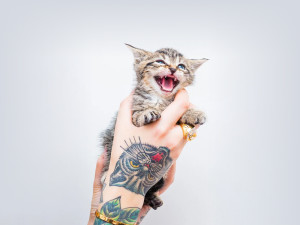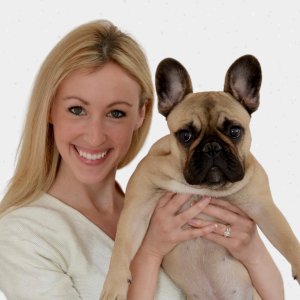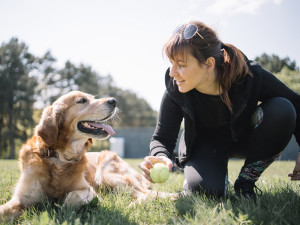Shelters Are Filling Up With “Designer Dogs”—Here’s Why
Want a purebred? Here’s yet another reason you should rescue one.
Shelters across the nation are grappling with a mounting (and maybe surprising) crisis: The number of purebred dogs and puppies struggling to find homes has reached alarming levels. Despite the initial surge in pet adoptions during the pandemic, changing circumstances, namely inflationopens in new tab, have led to an influx of shelter animals exacerbating an already dire situation. Those shelter populations now include the types of dogs you might expect to see on breeder websites, not in need of rescue.
Kinship spoke with experts to shed light on why this is happening and why, if you’re considering bringing home a purebred dog, the first place you should look is your local rescue.
Why are there so many purebreds and puppies in shelters?
Shelters have long had an overcrowding issue, and though that was temporarily relieved by the increase in adoptions during the pandemic, the tides have turned again. According to the Shelter Animals Count National Databaseopens in new tab, this is the third straight year with an increase in pets awaiting adoption, and more animals entered shelters in 2023 than those who left. Shelters are seeing a significant increase in puppies and purebreds in particular.
“These days, it’s not just ‘Pit Bulls and mutts’ that are getting surrendered, but designer dogs that people have paid north of $3,000 for that no longer fit into their personal or economic lifestyle,” says Shaina Denny, co-founder and CEO at Dogdropopens in new tab, a venture backed dog care start-up based in Los Angeles.
How much do you spend on your pet per year?
Labradoodles, Goldendoodles, French Bulldogs, and other designer and hybrid breeds that would rarely be found in shelters are now becoming commonplace. Why is this happening?
Irresponsible breeding practices
Irresponsible breeding practices are another significant contributor to the rising number of purebred dogs and puppies flooding into shelters. Breeders who prioritize profit over the welfare of the animals often engage in mass production without regard for genetic health or temperament, resulting in puppies with health issues and behavioral problems. These puppies are often sold through questionable online platforms or pet stores, and may end up in shelters when their pet parents face unexpected challenges or realize they can’t meet their needs.
There is a massive lack of regulation and oversight in the breeding industry, which only perpetuates the cycle of overpopulation and abandonment. But as long as people continue to support these breeders and shell out thousands for designer dogs, the cycle will continue.
Social media and influencer culture
The pervasive influence of social media and influencer culture cannot be ignored as a contributor to this problem. Instagram and TikTok often showcase adorable pets, portraying an idealized image of pet parenting without fully addressing the responsibilities and challenges involved. Influencers promoting specific breeds or showcasing designer puppies may inadvertently contribute to impulsive purchasing decisions by their followers, who may not fully understand the commitment required to care for these animals.
“Influence from social media and influencer culture has sparked a trend in pet parenting, with followers often seeking out trendy designer dogs,” Denny says. “However, the allure of these trendy breeds sometimes overshadows the responsibility of having a pet.”
He adds that, as a result, some pet parents realize they can’t afford the demands of caring for these specific breeds and end up surrendering them. He continues: “We urge dog parents to understand the responsibility of pet parenthood and to think through the next fifteen plus years before jumping on the bandwagon of a ‘cute’ breed they saw on TikTok.”
Ultimately, the pressure to keep up with trends and appearances on social media can lead to impulsive purchases of purebred dogs without considering adoption or responsible breeding practices. As a result, many of these pets end up abandoned or surrendered to shelters when their pet parents realize they are unable to meet their needs or maintain their desired image.
Lack of spaying and neutering
The failure to spay and neuter pets has long been a primary reason why we see a significant number of animals in shelters in general. Without these essential procedures, pets are left susceptible to unplanned breeding, which only worsens the problem of pet overpopulation.
Pet parents who choose not to spay or neuter may find themselves overwhelmed with litters of puppies, often unable to care for or find homes for all of them. As a result, many of these unwanted offspring end up in shelters, adding to the strain on already limited resources. Encouraging widespread spaying and neutering initiatives is crucial to curbing the cycle of overpopulation and reducing the number of animals entering shelters.
Economic factors
Current economic conditions play a significant role in the increasing number of purebred dogs and puppies ending up in shelters. The fallout from the pandemic has amplified this trend, despite the initial surgeopens in new tab in pet adoptions during lockdowns. But as economic hardships persist, many families find themselves unable to afford the costs associated with caring for a pet, leading to more animals being surrendered to shelters.
“The rising cost of living and market volatility, combined with the return to office, force pet parents to make tough choices about caring for their animals,” says Cerys Goodall, CEO at Vetsteropens in new tab. “Unfortunately, we now see some faced with a devastating decision to surrender their pets. Faced with rising financial burdens, people resort to shelters as a final option.”
How is this affecting adoptions of mixed breeds?
As purebreds and puppies infiltrate shelters, what does it mean for the other pups who’ve been there waiting for homes for months? Experts have mixed opinions, but what they do agree on is that it means that less dogs are getting adopted in general, regardless of breed.
“The influx of purebred and designer dogs in shelters can sometimes overshadow the adoption opportunities for mixed-breed and less ‘trendy’ dogs,” Denny says. “In previous years, it would be very rare to find a Doodle mix or Frenchie at a shelter. As a result, these mixed-breed dogs may face longer wait times for adoption or even overcrowding in shelters, affecting their chances of finding loving homes.”
Although a larger number of purebred dogs are ending up in shelters, some believe that it might not necessarily mean it’s any harder for a mixed-breed dog to get adopted. According to Dr. Jo Myers, veterinarian at Vetster, there are several factors that influence the likelihood of a particular dog getting adopted.
“The factors influencing the adoption rates of purebred dogs compared to mixed-breed dogs are complex and vary depending on the region, demographics, and individual preferences,” Dr. Myers says.
According to Dr. Myers, the likelihood of a particular type of dog getting adopted is influenced by:
Individual preferences for size, hair coat, energy level, etc., which can be found in both purebred and mixed-breed dogs
Marketing and presentation by the shelter organization
Supply and demand of popular versus less popular dogs in a given geographic area
Educational efforts by the shelter to help adopting families make informed decisions
“Adoption preferences are overwhelmingly subjective with different individuals having a variety of reasons for choosing a particular kind of dog,” Dr. Myers says. “When a shelter puts effort into matching families with the most appropriate dog to meet their needs — regardless of breed — prospective pet parents are more likely to enjoy a long and happy life with their canine companions.”
What can we do to support shelters right now?
There are several ways to support shelters during this period of increased demand. For one, consider adopting from shelters or rescues rather than purchasing from breeders, especially if you have your sights set on a purebred dog you could easily rescue. And when you do, make sure you get your dog spayed or neutered.
“Spreading awareness about the importance of adoption and responsible pet parenthood plays a crucial role in supporting shelters and reducing the number of animals in need of homes,” Denny says.
As the co-founder and CEO at Dogdrop, Denny says they’ve launched a new initiative. Until the end of April 2024, they’re offering two free weeks of dog daycare at all locations for families who adopt a dog.
“Our goal is to assist and encourage pet adoption while also providing valuable support and resources to new pet parents during this critical time,” Denny explains. “We believe that by offering this opportunity, we can help ease the transition for both pets and their families while promoting responsible pet parenthood and strengthening our community of pet lovers.”
Aside from the decisions you make as a pet parent yourself, you can also volunteer your time, donate supplies, or provide financial contributions. This applies to shelters as well as the organizations that support them by providing medical care and supplies for shelter animals.
“To remain sustainable, programs providing health care for shelter pets rely on charitable support and grants,” Dr. Myers says. “If the wellbeing of pets is a big priority for you, support these organizations as generously as you can. This is a big ask, though, when you consider that a major reason more dogs are ending up in shelters in the first place is economic pressure.”
By taking collective action and fostering a culture of compassion and responsibility towards pets, we can make a tangible difference in the lives of countless animals and support shelters in their mission to find loving homes for every dog in need.












